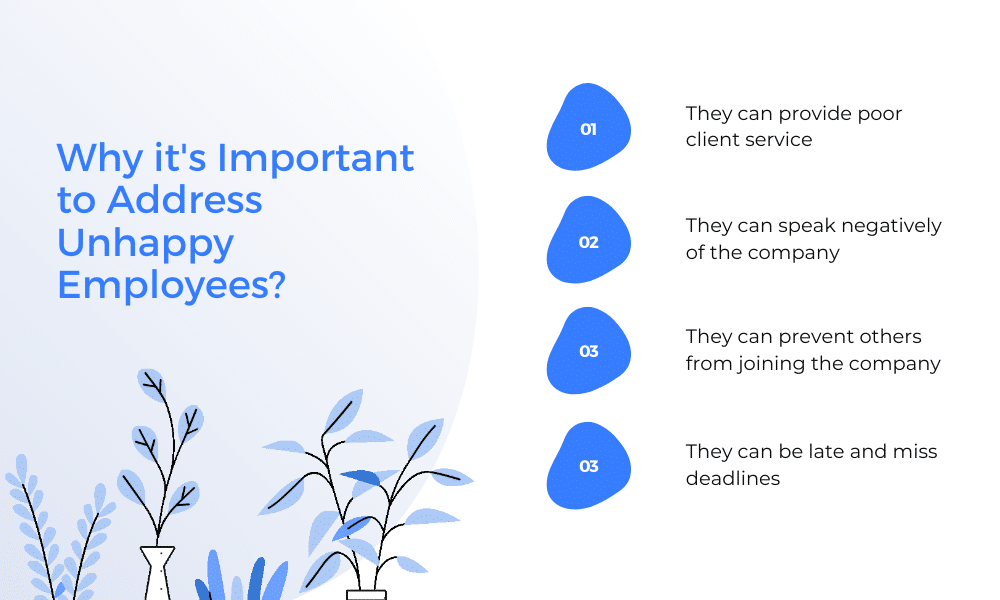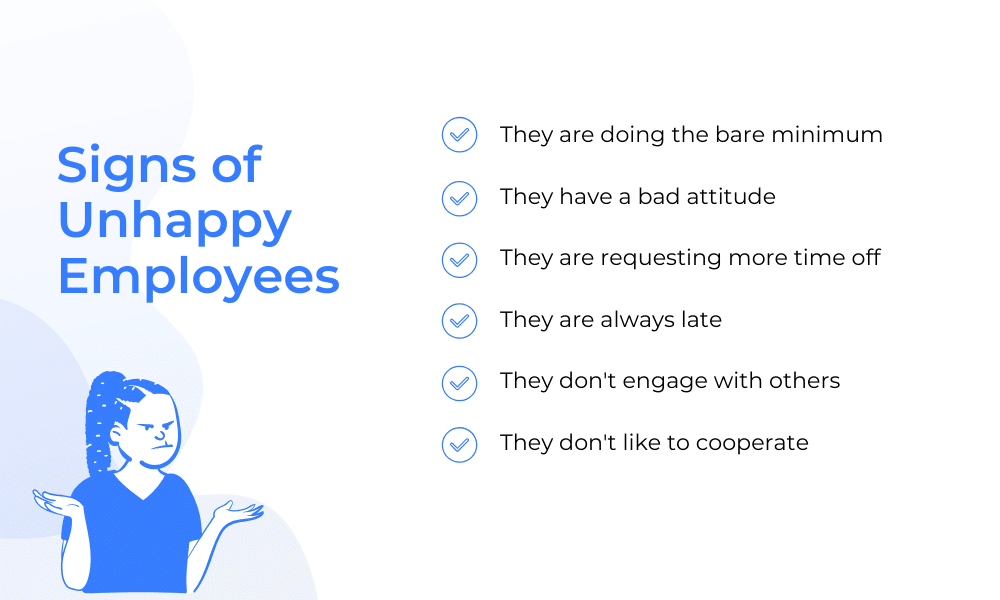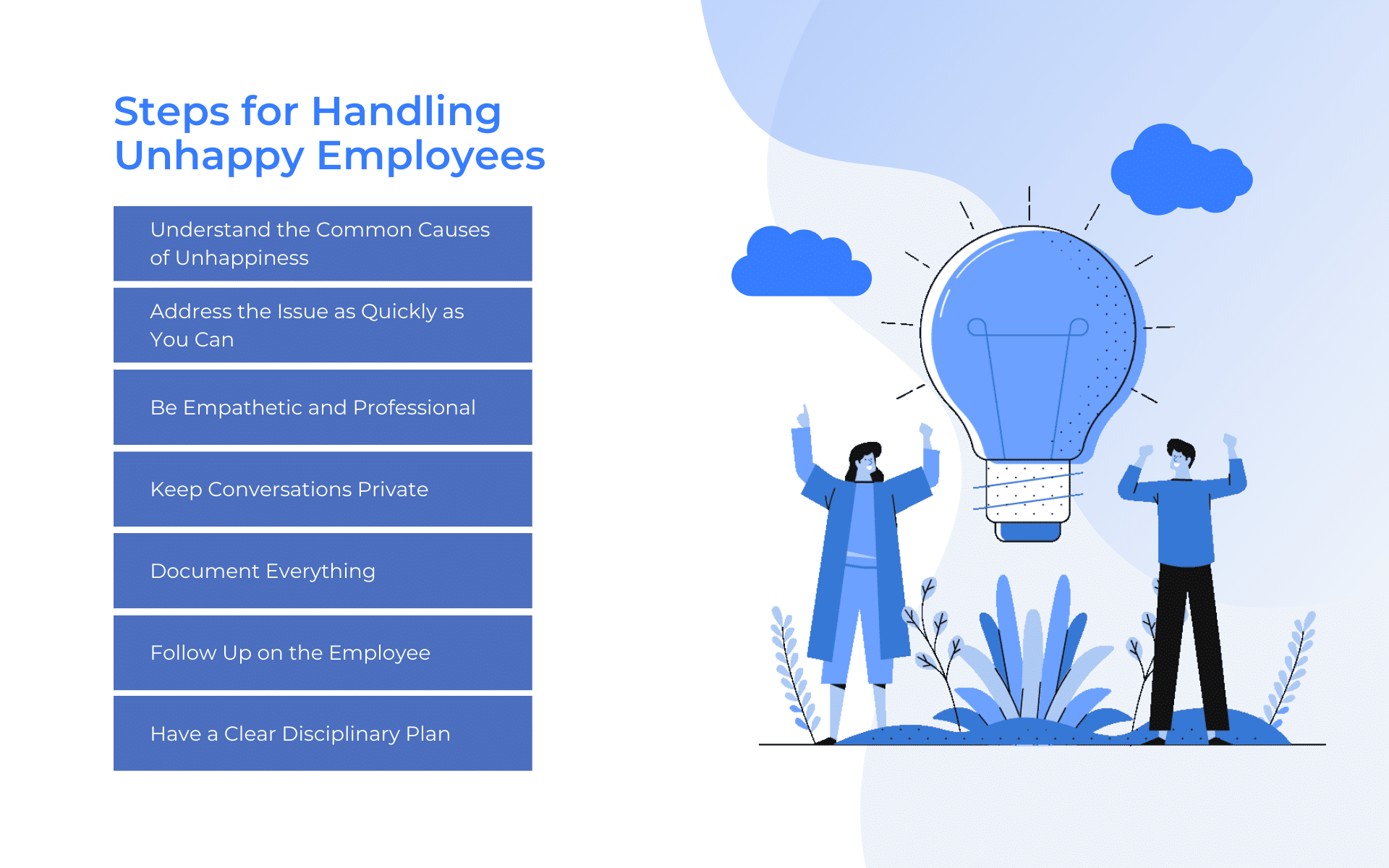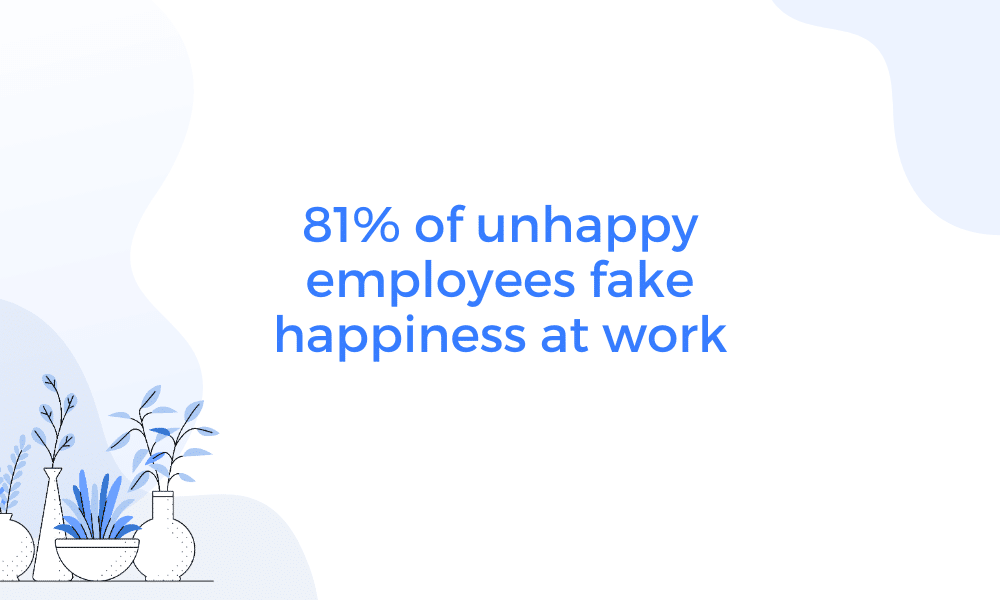How to Handle an Unhappy Employee

Do you have to handle an unhappy employee on your team?
The situation is widespread as more than half American workers currently feel unhappy at work , and 68% of them are disengaged.
These findings are unsettling because no matter how hard you work to create a fantastic work environment and collaborative team culture, one unhappy employee can erode overall employee engagement and ultimately hurt your business.
It’s essential to know how to handle unhappy employees before they cause irreversible damage to your company culture.
In this guide, we’ll help you recognize unhappy, disgruntled employees, and you will learn why it is crucial to address the situation.
We’ll also look into what you can do to prevent your employees from being miserable in the first place. Most importantly, we’ll give you steps to effectively hande unhappy employees.
Let’s dive right in!
What Is an Unhappy Employee?
An unhappy employee is a worker who complains a lot about their job. You can also refer to them as “disgruntled” employees. Career Minds highlights that “a disgruntled employee is an employee who is dissatisfied with their job and is prone to ‘grumbling’ about it.”
If you’ve noticed any of this behavior, then you have an unhappy employee in your team.
There are various reasons why an employee can be unsatisfied (which we will cover later), and companies can iron out most of them. However, it’s challenging to address these issues if employees don’t voice their concerns to management.
And unfortunately, it is very common for unhappy employees to keep quiet about their situation — 81 percent of unhappy employees fake happiness at work.
When you are busy with your tasks, it can be tempting to sweep this under the rug and hope that the situation will improve. Unfortunately, ignoring the unhappy employee problem can only harm your business.
Why Is it Important to Address Unhappy and Disgruntled Employees?
Picture this. You give your team the task of creating a marketing campaign for a new app your organization is about to release. The team has little over a month to do their market research, create a strategy, and put together the finer details for the campaign.
During meetings, everyone enthusiastically pitches their ideas and tries to create a winning campaign, but one team member continuously shoots down all the suggestions. They say things like, “this is not going to work” and “we should have had more time for this project.”
Over time, these little comments can, unfortunately, dampen the team’s spirit and the overall outcome of the project.

Disgruntled employees do more than just talk negatively around the office. They are actively disengaged at work and do not contribute to the success of your company. In turn, they can sabotage projects and harm other areas.
They can also:
- Speak negatively about the company and discourage potential employees from joining the company.
- Badmouth the company online.
- Continue to be late at work and miss important deadlines.
Disengagement is also noted to develop into some exceedingly bad habits, with Randstad USA noting that unhappy workers checked or posted on social media, took naps, watched Netflix, and even drank alcohol.
From the list above, it’s clear that unhappy employees can cause irreparable damage to the company. What’s worse, their dissatisfaction can quickly spread throughout the team and ultimately create an unhealthy work environment that erodes employee morale.
As the old saying goes: “One bad apple can spoil the bunch.”
Therefore, it’s crucial to resolve issues with unhappy employees before the problem reaches this stage. But of course, you first need to understand the common signs of disengaged employees.
Warning Signs That Your Employees Are Unhappy
Most employees aren’t going to tell their managers they’re unhappy at work openly. However, you can pay attention to the following signs as they are common indicators of disgruntled employees.

1. Doing the Bare Minimum
As a leader, you know the importance of exceeding client expectations more than anyone. You understand that this helps your organization stand out from your competitors and assists your business to grow.
If you have an employee who’s not willing to push themselves and will only meet the bare minimum expectations, this is a sign they may have lost interest in their work, and they are not concerned about the ramifications.
2. Bad Attitude
How an employee handles conversations during meetings or group activities says a lot about how happy they are. So, if an employee is continuously negative and speaking ill about everything and every one, this is a red flag.
3. An Increase in Absenteeism
Naturally, an unhappy employee will not enjoy coming in to work. So, pay attention to whether any of your team members are suddenly requesting more time off, or whether they are not showing up.
It’s important to note that absenteeism might not necessarily mean the employee hates their job. For example, their absenteeism could be a result of unforeseen issues in their personal life, or simply a bad day. Whatever the reason, once you see this sign, act fast by addressing the issue before it grows.
4. Excessive Tardiness
A happy employee looks forward to coming in to work. They are passionate about the projects they are working on and will often come in early or at least on time.
If your employee suddenly starts coming in late, taking long lunches, and seemingly counting down the hours until they knock off, this is a clear sign that they’re unhappy and don’t want to be at work.
5. Limited Engagement With Co-Workers
Every workplace environment brings together people from different walks of life. Some may naturally get along and even become friends, while others will hardly interact with one another.
This is natural.
While you can’t control how people feel about each other and how they interact, you can notice when an employee closes themselves off, and consider it a sign of unhappiness.
6. Reluctance to Cooperate
How do your employees act when you ask them to do something? Do they accept the task at hand and try to do their best, or do they complain by default?
Of course, if your instructions are unclear, they should ask for clarity or direction, but their questions should come from an authentic desire to meet or surpass expectations.
On the other hand, if an employee continuously displays a negative attitude and shows that they’re unwilling to cooperate, this is a clear sign that they are unhappy at work.
If you have an employee showing any of the signs mentioned above, this raises a concern. To help you effectively address the employee and reach a positive outcome, we’ve put together seven steps to take.
7 Steps for Handling Unhappy Employees
As discussed, unhappy employees can affect your team, your work environment, and the overall company. Once you’ve recognized you have an unsatisfied, disgruntled worker on your team, follow these steps to manage the situation effectively.

Step #1 Understand the Common Causes of Unhappiness
It’s difficult to fix a problem you don’t know. It’s therefore essential that you first understand why you have an unhappy employee before you can try to resolve the issue.
There are many reasons why someone becomes unhappy with their job. Often, this is related to the people we work with and the job itself, less often with outside factors.
Some of the most common causes of employee unhappiness are:
Not being recognized for hard work
When joining an organization, most employees are energized and excited about the new job. They often work hard to show management they were the perfect choice for the job and can live up to set expectations.
However, this excitement usually dwindles when employees realize they are not getting acknowledgment for their efforts.
Additionally, if someone else gets praise instead of the person responsible for results or if a senior co-worker steals their ideas and passes them off as their own — the employee will become resentful.
Office bullying
Over 60 million Americans have been bullied in the workplace. Bullying can be verbal or psychological, meaning it is sometimes not seen by others. This can leave your employee feeling emotionally distressed and ultimately affect their attitude towards the management and the whole company.
Lack of career growth opportunities
Most employees want to develop professionally. They want to learn and earn more. If they feel they have hit the wall and that there are no more growth opportunities, then they cannot fulfill their ambition and are likely to become unhappy.
Lack of work-life balance
The importance of maintaining a healthy work-life balance has, in recent years, become one of the hot topics for employee satisfaction.
The Happiness Index perfectly explains it.

If an employee feels overwhelmed with their work and doesn’t have enough time to take care of themselves and form meaningful relationships outside of work, they will not lead a fulfilled life and will foster negative sentiments about the company.
Workplace favoritism
When a relevant promotion becomes available, your employees want to know that they have a fair shot of getting it. This opportunity will encourage them to work harder and show how valuable they are.
If someone not fit for the job receives the promotion just because they get along with the boss, this will inevitably lead to resentment and many disgruntled employees. Employees notice favoritism, and it hinders their career aspirations.
Sexual harassment
The #MeToo movement helped in uncovering countless victims of sexual harassment in the workplace. Although laws have become more strict to help reduce incidents, unfortunately, there are still many cases that go unnoticed.
If an employee is experiencing sexual harassment, they will, understandably, not feel safe or comfortable at work, and will start dreading even coming in.
Personal Issues
Employees are often expected to put personal issues aside when they come to work. But sometimes, persistent or unresolved domestic or health problems will inevitably slip into their professional lives and affect their happiness.
From the list above, it’s clear that there are many reasons why an employee can become unhappy. Take your time to understand each of these common reasons, so when you approach the employee, you will come prepared and understand the underlying problem better.
Step #2 Address the Issue as Quickly as You Can
When you realize you have an unhappy employee on your team, act!Don’t make the mistake of underestimating the problem or thinking that will go away by itself. Unfortunately, ignoring the problem won’t help. You might feel uncomfortable facing the issue, but sweeping it under the rug isn’t the answer.
Face the problem head-on and lead your team back to the synergy they need to perform at their best.
Step #3 Be Empathetic and Professional
After deciding to act on it, it’s time to do it in the right way. Set a meeting with the unhappy employee to discuss the matter. Give the employee a chance to speak their mind and let them feel heard.
In addition to showing empathy, you should also act professionally at all times. The employee may start shouting, show aggression, or even cry. The employee might even pretend like everything is fine and resist providing information.
Whatever the reaction, you should remain calm and professional.
It’s essential to try to understand where they are coming from, and to acknowledge their feelings, whether or not you agree with their behavior. Empathy and understanding go a long way and will set the right tone for the process.
Step #4 Keep Conversations Private
Along with remaining professional, it’s important to keep things private. If you approach your unhappy employee in front of others, there’s a good chance you won’t receive the desired outcome. They may become embarrassed, hostile, shut down, and be even more unhappy with their job.
Meet with an unhappy employee in a private place.
If the matter has become so big that it has affected the whole team, you may need to address your team after talking to the unhappy employee. But even if this occurs, you don’t need to divulge all the information from your private meeting.
For example, the rest of the team doesn’t need to know that the employee is unhappy because he/she is going through a divorce. You can easily phrase this as “a personal matter.”
If you have to share information with your team or superiors, approach it on a need-to-know basis.
Step #5 Record and Document
While trying to find a solution to the unhappy employee’s behavior, it’s vital that you document the whole process.
Keep records of the employee’s behavior, the conversations you had with them, the time of each meeting, and the outcomes. If you decide that giving the employee a warning is a necessary step, you’ll need to document it.
Ideally, after addressing the unhappy employee, you’ll both reach an understanding, and their behavior will change for the better. But that’s not always the case.
Sometimes the already unhappy employee gets aggravated and may decide to take legal action against the company. If the situation escalates to that point, keeping a paper trail will protect you.
Step #6 Follow Up on Employee’s Development
Make the time to check in with the disgruntled employee to see how things have progressed since you last spoke. This can easily be achieved through a follow-up private meeting. Ask the employee whether they feel more positive about the job, and monitor their behavior closely to see if the situation has improved.
Following up is an essential step of this process, and it has many valuable benefits:
- Your employee will feel valued and heard.
- You will see if the measures you agreed upon have helped to fix the problem.
- If the situation hasn’t improved, it helps you determine if you need further action to fix the problem.
There are situations when employees refuse to work with you. They may refuse to take the actions you requested, or they may exhibit threatening behavior to you, their co-workers, or the company. If this occurs, it may be time to follow your disciplinary procedure.
Step #7 Have a Clear Disciplinary Plan
If your unhappy employee doesn’t change and continues to be disruptive, it may be time for official disciplinary action.
Therefore, you should have a clear disciplinary procedure. Companies usually have various ways of handling this. Some may use different disciplinary levels. For instance, a verbal warning can come first, then a written notice, then a suspension, and lastly, firing. Other companies have a simpler three-strike system.
Before taking disciplinary action, make sure that:
You have communicated what you want the employee to improve on.
Do they gossip around the office and cause tensions amongst their co-workers? Are they always late? Do they have a negative attitude during meetings or company activities? The employee needs to know what the issue is precisely and what do you want them to improve.
You kept written records of all communications with the employee.
As previously mentioned, you’ll need to keep accurate records of every conversation and meeting you’ve had with the employee to resolve the problem. Besides the fact that it will help protect you and your company if the employee decides to take the matter up with the law, keeping records will also help keep the facts straight.
A disciplinary plan is there to give the unhappy employee a chance to improve their negative behavior.
If, however, it just doesn’t work, then the last resort may be to let go of the employee.
Firing a member of your team is not a fun process. The following guidelines can help you manage the situation better.
Always remain respectful.
If the unhappy employee loses their cool, it doesn’t mean you should too. While terminating their position, it’s best to keep things brief and straightforward to end the meeting or conversation as soon as possible. If you followed your disciplinary plan, then the termination won’t be a surprise, and it will likely go well.
Have a neutral person carry this out.
If the employee has been giving you problems for some time, and their behavior isn’t improving, you can reasonably become frustrated. However, this frustration can quickly turn into anger, and you might say something during the termination process you might regret. To mitigate this chance, you can have someone else take over or join you in the termination meeting.
Allow the employee to resign first.
Although you might be frustrated with the unhappy employee who hasn’t shown they want to improve their behavior, consider allowing them to resign. Remind them that resigning may help them qualify for unemployment benefits and keep a level of dignity.
Request a security guard to be nearby.
Having security nearby is especially crucial for unhappy employees who’ve demonstrated that they are aggressive and emotionally unstable. Firing them can trigger different emotions, and you wouldn’t want anyone to get hurt.
Besides causing physical harm to others, such employees can also take this as an opportunity to harm the company by stealing or damaging valuable assets. Having a security guard nearby will help to prevent this from occurring.
How to Prevent Having Unhappy Employees in the First Place
So far, we’ve spoken at length about recognizing, understanding, and dealing with an unhappy employee.
But, could you prevent unhappiness in the first place?
What if you have the power to make your employees feel happy and enthusiastic about coming into work every day?

While it’s impossible to make every employee happy, we have put together a list of preventative measures to help your employees become more productive and happy at work.
Take interest in their career development
Career development is very important to people. No one wants to feel stuck in the same job for the rest of their lives. Not having the opportunity to progress is a quick way to make an employee lose motivation and start having a bad attitude towards the job.
Encourage your employees to attend work-related training to improve their knowledge. If possible, organize training yourself.
It’s also a good habit when a new project presents itself, to give different employees various responsibilities. This will challenge them, help them gain experience, and will make their work continuously challenging and rewarding.
Be an encouraging leader
One of the key elements of being a great leader is encouraging and motivating your team to perform better.
Too often, managers approach employees negatively and continuously point out their flaws and what they are getting wrong.
While it’s important to highlight the problem areas, it’s equally important to take note of what the person is getting right.
If a meeting went well and there were great suggestions—say so.
If an employee who has been coming late is now arriving on time—let them know you’ve noticed the improvement.
If an employee has been working late in the office to complete a project—tell them you appreciate it.
Get rid of silo mentality in the workplace
Silo mentality can be defined as a reluctance to share information with employees of different divisions in the same company.
The problem with having workplace silos is that it limits collaborations and causes further divides amongst departments and employees. If employees feel on the outside, that will negatively affect how they view the organization and their jobs.
So, encourage collaborations amongst your teams, create a unified vision, and communicate effectively by keeping everyone well-informed.
Connect with your employees on a personal level
People spend a lot of time with their co-workers. If you have full-time staff, that’s around 40 hours per week with each other.
While it’s important to discuss work projects and activities, it’s also essential to check in with everyone on a personal level.
A simple question: “How are the kids?” or “How are you today?” can help an employee feel seen and valued.
Handling an Unhappy Employee Is a Process
By this point, one thing should be clear – resolving the problem of an unhappy employee isn’t going to happen overnight. It’s a lengthy process that involves understanding, listening, providing guidelines, following-up, and motivating.
The process might be frustrating, but the rewards for your company are going to be worth it.
So, take your time in handling unhappy employees and turning the whole team spirit around.
Lastly, look into your management skills to see what you can improve on. Encourage your employees, inspire them, advocate for more collaborations, and connect with them more.
All this will help you create a great team of passionate individuals, which will have a fantastic impact on your company.
